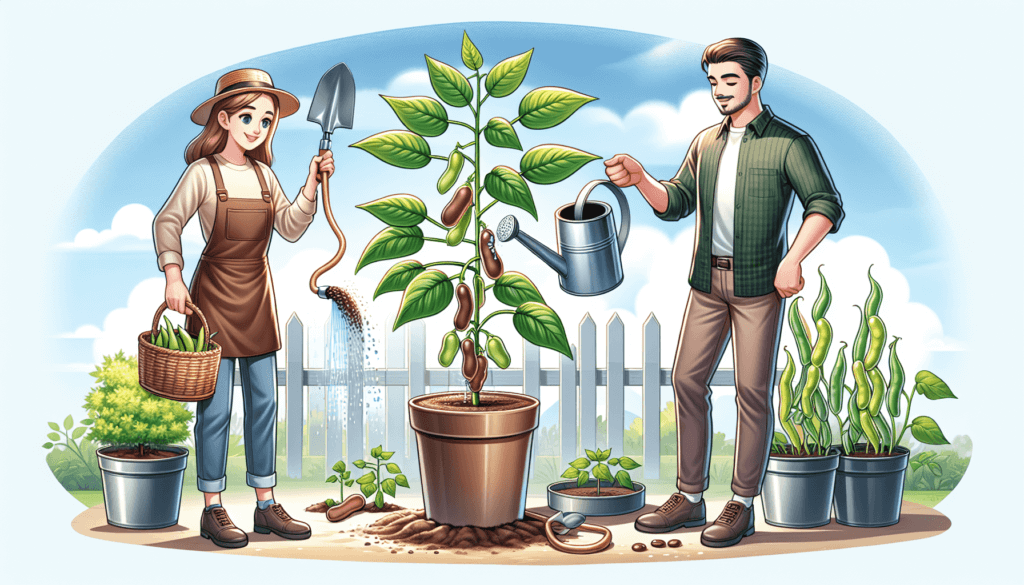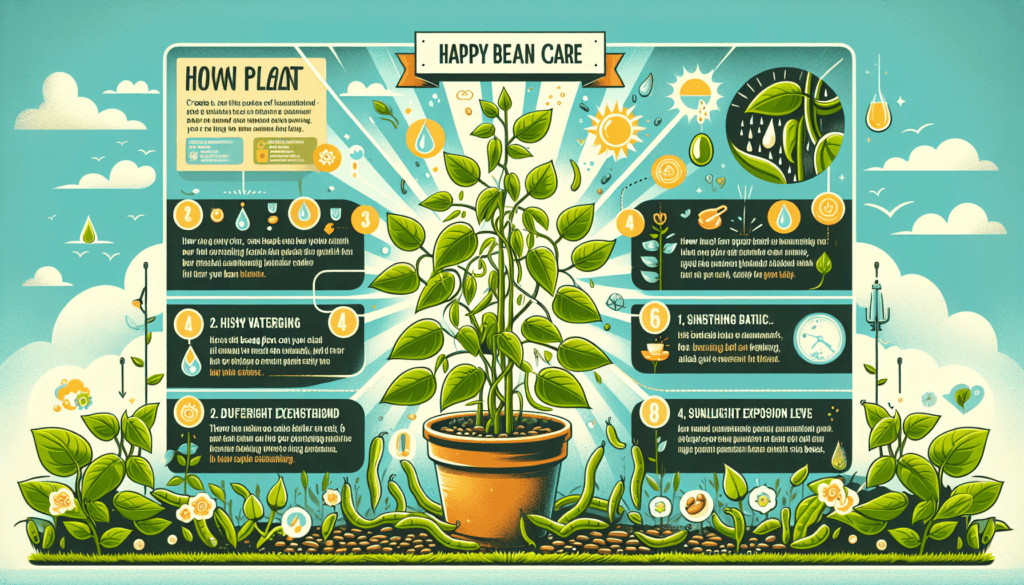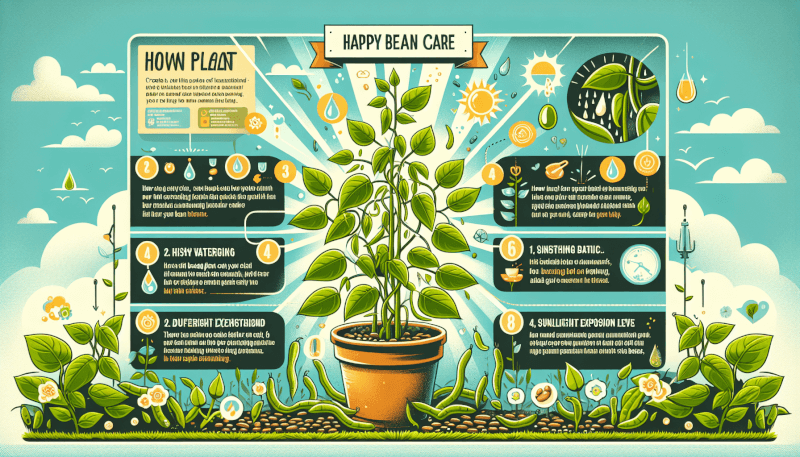You love the feeling of being surrounded by greenery and the simple joy of watching plants thrive. If you’re looking to add a unique touch to your indoor garden, then look no further than the Happy Bean Plant. Known for its whimsical appearance and easy maintenance, the Happy Bean Plant is the perfect addition to any plant lover’s collection. In this article, we will explore all the essential care tips to ensure that your Happy Bean Plant stays healthy and happy, bringing a dose of joy to your living space.

Plant Selection
Choosing the Right Variety
When it comes to planting beans, selecting the right variety is crucial. There are numerous types of beans available, including bush beans, pole beans, and snap beans. Consider your needs and preferences when choosing a variety. Bush beans are compact and suitable for small spaces, while pole beans require support and are ideal for larger gardens. Snap beans can be eaten whole, while other varieties may need to be shelled. Research the different varieties and choose the one that will thrive in your specific growing conditions and meet your culinary requirements.
Finding a Healthy Plant
Once you’ve determined the variety you want to grow, it’s important to find a healthy plant. Look for plants that have vibrant, green leaves and sturdy stems. Avoid plants that have yellowing or wilting leaves, as these may indicate poor health. Check the roots as well – they should be white and firm, rather than brown or mushy. It’s also a good idea to inspect the plant for any signs of pests or diseases. By starting with a healthy plant, you’ll give your beans the best chance of flourishing and producing a bountiful harvest.
Considering Indoor or Outdoor Growing
Another factor to consider when selecting bean plants is whether you’ll be growing them indoors or outdoors. Beans thrive in full sun, so if you have a sunny spot in your garden, planting them outdoors is a great option. However, if you don’t have access to an outdoor space or live in a region with a short growing season, growing beans indoors is a viable alternative. Indoor bean plants will require artificial lighting and careful monitoring of temperature and humidity levels. Consider your available space and resources when deciding whether to grow beans indoors or outdoors.
Light Requirements
Providing Ample Sunlight
Beans are sun-loving plants that require at least 6 to 8 hours of direct sunlight per day. When planting beans outdoors, choose a location that receives the most sunlight throughout the day. Orient your garden bed or containers to maximize exposure to the sun. If you’re growing beans indoors, place them near a south-facing window or invest in grow lights to provide the necessary amount of light. By ensuring your beans receive ample sunlight, you’ll promote healthy growth and maximize their potential for yield.
Using Grow Lights Indoors
If you’re growing beans indoors, supplementing natural sunlight with grow lights is essential for their successful development. LED grow lights are a popular choice as they emit the ideal spectrum of light for plant growth. Position the grow lights a few inches above the plants to mimic the intensity of the sun. It’s important to provide a consistent light source by setting a timer for 12 to 16 hours of light per day. This will ensure that your indoor beans receive the necessary light energy to thrive and produce high-quality beans.
Avoiding Direct Sun During Hot Afternoons
While beans require ample sunlight, it’s important to protect them from intense heat during the hottest hours of the day, especially in the afternoon. Extreme heat can cause stress and dehydration in the plants, leading to wilting and reduced productivity. Consider providing some shade during the hottest part of the day, either through the use of shade cloth or by positioning taller plants nearby to provide natural shade. By avoiding direct sun during hot afternoons, you’ll help your beans maintain their vitality and prevent damage from excessive heat.
Watering Needs
Understanding Moisture Requirements
Proper watering is crucial for the health and productivity of your bean plants. Beans prefer consistently moist soil, but they don’t like to sit in waterlogged conditions. Before watering, check the moisture level of the soil by inserting your finger about two inches deep. If the soil feels dry at this depth, it’s time to water. It’s important to strike a balance between allowing the soil to dry out too much and overwatering. Understanding your bean plants’ specific moisture requirements will help you maintain optimal soil conditions.
Watering Frequency
The frequency of watering will depend on various factors such as the temperature, humidity, and type of soil you’re using. Generally, beans require watering about 1 to 2 inches per week, evenly distributed. However, during hot and dry periods, you may need to increase the frequency to ensure the soil doesn’t dry out. Monitor the moisture level of the soil regularly and adjust your watering schedule accordingly. It’s better to water deeply and less frequently, allowing the roots to access the water and encouraging them to grow deeper into the soil.
Avoiding Overwatering
Beans are susceptible to root rot and other diseases caused by overwatering. It’s essential to avoid excessive moisture that can lead to waterlogged conditions. Overwatering can suffocate the roots and create an environment favorable to fungal growth. To prevent overwatering, ensure that the soil has adequate drainage and that excess water can escape freely. Consider using raised beds or containers with drainage holes. If you notice signs of overwatering, such as wilting or yellowing leaves, adjust your watering practices to avoid further damage.
Monitoring Soil Moisture
To maintain the ideal moisture level for your bean plants, it’s important to regularly monitor the soil moisture. Invest in a moisture meter or conduct the finger test described earlier to assess the soil’s moisture content. By consistently checking the soil moisture, you’ll be able to make informed decisions about when and how much to water. Remember that different environmental conditions, such as temperature and humidity, can affect the soil’s moisture levels, so monitoring is key to providing optimal care for your bean plants.
Temperature and Humidity
Ideal Temperature Range
Beans thrive in moderate temperatures, with the ideal range being between 70°F and 85°F (21°C to 29°C). Cooler temperatures can slow down the growth, while hotter temperatures can cause stress and reduce productivity. To ensure the best possible conditions for your beans, monitor the temperature regularly and take appropriate measures to maintain an optimal range. If the temperature is consistently outside the ideal range, consider adjusting your planting schedule or providing additional protection to mitigate the effects of extreme temperatures.
Avoiding Extreme Temperatures
While beans can tolerate some temperature fluctuations, extreme heat or cold can be detrimental to their growth. Extreme heat can cause wilting, flower drop, and reduced bean production. On the other hand, frost and freezing temperatures can damage the plants and inhibit their growth. To protect your beans from extreme temperatures, consider using row covers or cloths to provide shade during hot periods and to protect them from frost during colder months. By avoiding extreme temperatures, you’ll help your beans thrive and ensure a successful harvest.
Maintaining Relative Humidity
Beans prefer moderate humidity levels, ideally between 40% and 60%. In areas with low humidity, such as arid regions or indoor environments with air conditioning, the air can become dry and affect the plants’ health. To increase the humidity around your bean plants, you can use a humidifier or place a tray filled with water near the plants. The evaporating water will help raise the humidity level. Proper humidity regulation will aid in water uptake, reduce stress, and promote healthy growth in your bean plants.
Misting Leaves in Dry Environments
In dry environments or when humidity levels are low, misting the leaves of your beans can help mimic the natural conditions they prefer. Use a spray bottle filled with water and mist the leaves lightly, ensuring that it reaches both the upper and lower surfaces of the leaves. Misting helps increase the moisture around the plant, reducing the risk of dehydration and leaf damage. However, avoid misting during the evening or night, as damp leaves during cooler periods can increase the likelihood of fungal diseases.

Soil Requirements
Choosing Well-Draining Soil
Beans thrive in well-draining soil that provides good aeration and allows excess water to escape. When selecting soil for your bean plants, choose a loamy or sandy soil that drains well. Avoid clay soils or those that become compacted easily, as they can hold excess moisture and lead to root rot. If you have heavy soil, you can improve drainage by amending it with organic matter or creating raised beds. Well-draining soil will help promote healthy root development and prevent waterlogging and related issues.
Adding Organic Matter
To improve the overall health and fertility of the soil, it’s beneficial to add organic matter. Organic matter, such as compost or well-rotted manure, enriches the soil by providing essential nutrients and improving its structure. Before planting your beans, mix organic matter into the soil, ensuring it’s evenly distributed. This will not only provide a nutrient-rich environment for your plants but also enhance moisture retention and drainage. Regularly adding organic matter to the soil will promote long-term soil health and contribute to the success of your bean plants.
Avoiding Compacted Soil
Beans need loose, friable soil to grow and spread their roots effectively. Compacted soil can hinder root development, restrict nutrient uptake, and impede water drainage. Avoid walking or working on the soil when it’s wet, as this can lead to compaction. If your soil becomes compacted, use a garden fork or a tiller to loosen it. Additionally, considering raised beds or containers can help eliminate the issue of compacted soil. By ensuring your bean plants have loose soil, you’ll create an environment conducive to healthy root growth and overall plant vigor.
Fertilization
Choosing the Right Fertilizer
Beans are typically moderate feeders and generally don’t require heavy fertilization. However, providing them with a balanced fertilizer can promote vigorous growth and improve overall productivity. When choosing a fertilizer, opt for one that is specifically formulated for vegetables or beans. Look for a balanced NPK ratio (nitrogen, phosphorus, and potassium) to provide the essential nutrients your bean plants need. Follow the instructions on the fertilizer packaging to ensure you’re applying the correct amount for your plants.
Frequency of Fertilization
The frequency of fertilization will depend on the specific fertilizer you’re using and the soil conditions. As a general guideline, it’s recommended to fertilize bean plants once a month during the growing season. However, if you’re using a slow-release fertilizer, it may be sufficient to apply it at the beginning of the season. Pay attention to the growth and appearance of your plants – if they show signs of nutrient deficiency, such as pale leaves or slow growth, consider increasing the frequency of fertilization accordingly.
Avoiding Over-Fertilization
While fertilization is important for the health of your bean plants, it’s crucial to avoid over-fertilization. Too much fertilizer can lead to excessive vegetative growth at the expense of bean production. Additionally, excessive nitrogen can make the plants more susceptible to diseases and pests. Follow the recommended dosage and avoid applying more fertilizer than necessary. Regularly monitor the overall health and growth of your plants and adjust your fertilization practices if needed. Striking the right balance will ensure optimal plant development and a successful bean harvest.
Pruning and Training
Removing Dead or Yellowing Leaves
Pruning your bean plants can help improve their overall health and productivity. One of the simplest pruning tasks is to remove dead or yellowing leaves. These leaves are no longer contributing to the photosynthesis process and may attract pests or diseases. Use clean and sharp pruning shears to carefully remove any dead or yellowing leaves, making clean cuts near the base of the stem. Regularly inspect your bean plants and prune as needed to maintain a tidy and healthy appearance.
Trimming Excessive Growth
If your bean plants are growing excessively and becoming tangled or crowding other plants, it may be necessary to do some trimming. Trimming excessive growth helps improve air circulation, reduces the risk of diseases, and allows sunlight to reach inner parts of the plant. Use pruning shears to carefully remove any excessively long or tangled stems. It’s important to strike a balance between removing enough growth to improve plant health while still retaining enough leaves for photosynthesis. Trimming should be done selectively throughout the growing season, as needed.
Supporting Vines with Trellises
Tall-growing varieties of beans, such as pole beans, often require support to grow vertically and maximize space. Using trellises or stakes is a common method of providing support to climbing bean plants. Place the trellises or stakes prior to planting, ensuring they are securely anchored in the ground. As the bean plants grow, gently guide the vines onto the trellis or tie them loosely to the stakes. Supporting the vines not only helps prevent them from sprawling on the ground but also promotes better airflow and ease of harvesting.
Pest and Disease Control
Identifying Common Pests
Beans can be susceptible to various pests that can damage the plants and reduce yield. Some common pests to watch out for include aphids, spider mites, bean beetles, and caterpillars. Aphids and spider mites suck the sap from the plants, causing stunting and leaf curling. Bean beetles feed on the foliage and pods, while caterpillars can chew through leaves and cause extensive damage. Regularly inspect your bean plants for signs of pests, such as curled or distorted leaves, holes in foliage, or visible insects.
Preventing Infestations
Preventing pest infestations is crucial for maintaining healthy bean plants. Start by practicing good garden hygiene – remove any weeds or debris that may harbor pests. Consider companion planting with pest-repelling plants, such as marigolds or garlic, to deter pests naturally. Introducing beneficial insects, such as ladybugs or lacewings, can help control pest populations. Additionally, using row covers can provide a physical barrier, preventing pests from reaching your plants. By implementing preventative measures, you can minimize the risk of pest infestations and reduce the need for chemical controls.
Natural Pest Control Methods
If you notice a pest problem in your bean plants, there are several natural pest control methods you can try before resorting to chemical pesticides. One effective method is to spray a mixture of water and mild soap onto the affected plants. This can help suffocate and kill soft-bodied pests like aphids. Another option is to make a homemade insecticidal spray using ingredients like neem oil or garlic. These natural remedies can be effective in controlling pests while minimizing harm to beneficial insects and the environment.
Recognizing and Treating Diseases
While beans are generally resilient, they can still be susceptible to diseases. Some common bean diseases include powdery mildew, rust, and bacterial blight. Powdery mildew appears as a white powdery coating on the leaves, while rust causes orange or brown spots. Bacterial blight leads to brown spots on leaves, pods, and stems. If you notice signs of disease, remove and destroy affected plant parts to prevent the spread. Fungicidal sprays may be necessary for controlling fungal diseases. Proper sanitation, good air circulation, and avoiding overhead watering can help prevent diseases in the first place.
Harvesting Beans
Determining the Right Harvest Time
Knowing when to harvest your beans is essential for optimal flavor and tenderness. The timing will depend on the variety you’re growing, as well as your personal preference. Most beans are harvested when the pods are still young and tender. Snap beans are typically harvested before the seeds inside the pods fully develop, while shelling beans are allowed to reach full maturity before harvesting. Monitor the size and color of the pods and harvest when they are at the desired stage – plump and crisp for snap beans, or dry and fully mature for shelling beans.
Harvesting Methods
Harvesting beans can be done by carefully snapping or cutting the pods from the plants. Snap beans should be harvested by snapping the pods off the stem using your fingers, ensuring that the tip of the pod breaks with a clean snap. For shelling beans, allow the pods to dry on the plants until they turn brown and become brittle. Gently remove the pods from the plants and open them to collect the dry seeds inside. Harvesting should be done regularly to encourage continuous production and prevent over-maturity or the loss of quality.
Preserving Beans
If you have a surplus of beans or want to enjoy their freshness throughout the year, it’s possible to preserve them for later use. One common method of preserving beans is by freezing. Blanch the beans in boiling water for a few minutes, then immediately transfer them to an ice bath to stop the cooking process. Drain the beans and package them in airtight containers or freezer bags for long-term storage in the freezer. Another preservation method is canning, where beans are cooked and packed into sterilized jars. Be sure to follow proper canning guidelines for safe preservation.
Common Issues and Troubleshooting
Yellowing Leaves
Yellowing leaves on your bean plants can be a sign of various issues, including nutrient deficiencies, overwatering, pests, or diseases. To troubleshoot this problem, check the overall health of the plant, monitor watering practices, and inspect for signs of pests or diseases. Adjust fertilization if necessary and ensure that the soil is well-draining. Address any pest infestations or diseases promptly. By identifying and addressing the underlying cause of yellowing leaves, you can restore the health of your bean plants and promote vibrant foliage.
Wilting Plants
Wilting plants can indicate a lack of water or excessive heat. Check the moisture level of the soil and adjust your watering practices accordingly. If the soil is adequately moist, consider providing shade during hot afternoons and ensuring proper air circulation around the plants. Wilting can also be a sign of root rot caused by overwatering or poorly draining soil. If this is the case, improve the drainage and avoid excess moisture. Monitoring and adjusting the watering and environmental conditions will help revive your wilting bean plants.
Poor Bean Production
If your bean plants are not producing an abundant harvest, several factors could be contributing to this issue. Inadequate sunlight, improper fertilization, pests, or diseases can all affect bean production. Ensure that your plants are receiving sufficient sunlight and adjust the fertilization if necessary. Inspect for signs of pest infestations or diseases and take appropriate measures for control. Lack of pollination can also lead to poor bean production – consider attracting pollinators or manually pollinating the flowers. Addressing these factors will help improve bean production and increase your yield.
Root Rot Prevention
Root rot can be a common issue for beans, especially in poorly draining or overwatered soil. To prevent root rot, ensure that the soil has good drainage and avoid overwatering. Choose well-draining soil or amend it with organic matter to improve its structure. Additionally, practice proper watering techniques, allowing the soil to dry out slightly before watering again. Avoid excessive moisture and address any drainage issues promptly. Taking preventive measures against root rot will help maintain the health and productivity of your bean plants.
In conclusion, successfully caring for happy bean plants requires careful consideration of various factors. Choosing the right variety, providing adequate sunlight or grow lights, and maintaining proper watering practices are crucial for their growth. Paying attention to temperature and humidity, as well as soil quality and appropriate fertilization, will further ensure their health. Pruning, training, and implementing pest and disease control measures will help maintain the plants’ vitality. Harvesting at the right time and preserving the beans for long-term use can be rewarding. With proper care and attention, you’ll enjoy a bountiful harvest of delicious beans straight from your garden.


